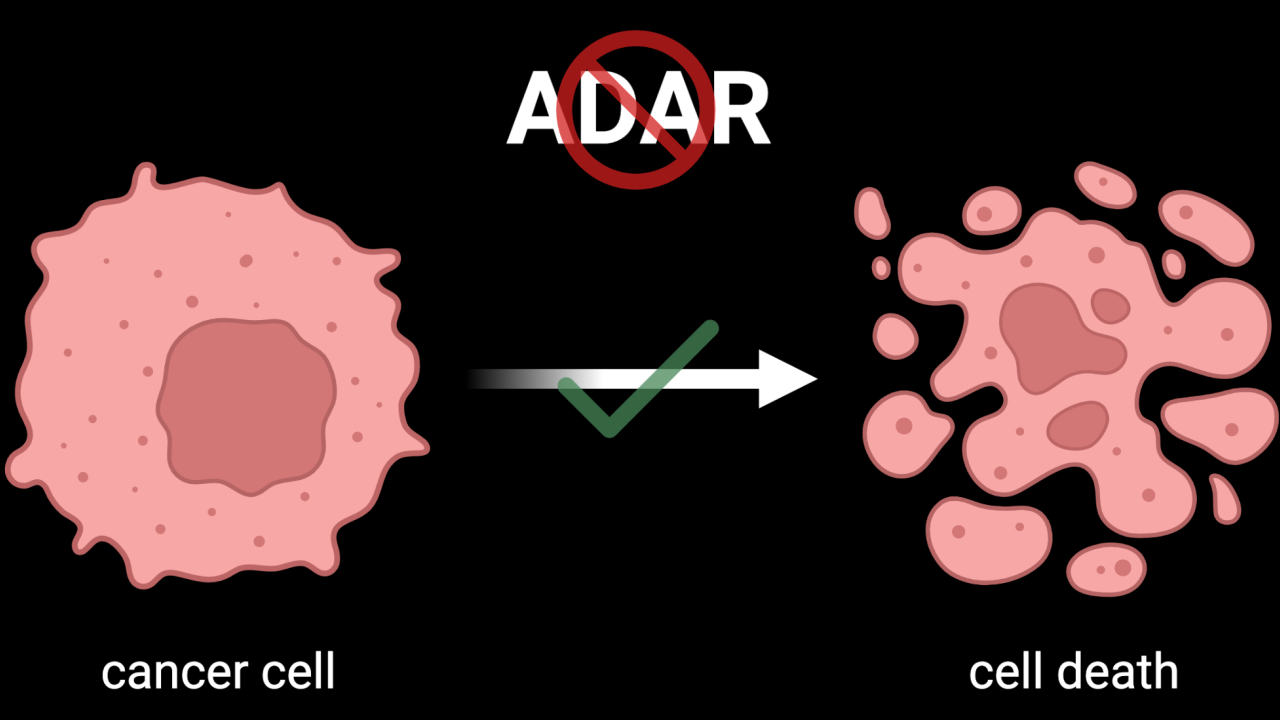
ADAR Inhibitors - Future Cancer Therapeutics
In recent years, the field of cancer research has witnessed a growing interest in targeting RNA editing as a potential therapeutic strategy. Adenosine Deaminase Acting on RNA (ADAR), a key enzyme involved in RNA editing, has emerged as an attractive target for cancer therapy. In this blog post, we will explore the role of ADAR and RNA editing in cancer and the potential of ADAR inhibitors as effective cancer therapeutics, highlighting the progress made in this area and the challenges that lie ahead.
From my second blog, we learned that RNA editing is a post-transcriptional process that expands the genetic information encoded by DNA. The most prevalent type of RNA editing is the conversion of the nucleotide base adenosine (A) to inosine (I), which is majorly catalyzed by ADARs. This results in an altered RNA sequence and subsequent changes in protein synthesis.
ADAR-mediated RNA editing (Figure 1) has been shown to play a dual role in cancer, with both tumor-suppressive and tumor-promoting or oncogenic effects. On one hand, ADARs can act as guardians against cancer by selectively editing and altering the coding sequences of oncogenic transcripts, effectively reducing their protein levels. By targeting and disrupting the RNA structure, ADARs can also inhibit the translation of genes involved in cancer cell proliferation, invasion, and formation of new blood vessels to support tumor growth. Conversely, aberrant expression or dysregulation of ADARs in cancer cells can also lead to detrimental consequences. Abnormal ADAR activity has been linked to the generation of edited protein variants or isoforms that promote tumor growth, metastasis, and drug resistance. Additionally, ADAR-mediated editing events can alter the RNA splicing process, resulting in the production of different isoforms that contribute to tumor heterogeneity. ADARs can also introduce editing changes in non-coding regions in the transcriptome (e.g. 3’-UTRs, miRNA), impacting their stability and normal regulatory function.
The immune system also plays a vital role in recognizing and eliminating cancer cells. Studies have uncovered a connection between ADAR-mediated RNA editing and immune response evasion in cancer. ADARs can edit transcripts of immune checkpoint protein molecules leading to increased stability and expression. This editing process helps cancer cells evade immune surveillance and hinder the effectiveness of immunotherapies targeting immune checkpoints. ADAR binding and editing activity have also been found to suppress immunostimulatory RNAs in tumor cells, leading to their survival.

The correlation of ADAR activity and RNA editing dysregulation with cancer progression, metastasis, and drug resistance has prompted researchers to explore the therapeutic potential of ADAR inhibitors. By selectively inhibiting ADAR activity, it is possible to modulate the RNA editing landscape in cancer cells and potentially disrupt key oncogenic pathways. ADAR inhibitors could then offer a unique avenue to target cancer vulnerabilities associated with dysregulated RNA editing.
Despite the findings described above, there are currently no FDA-approved ADAR inhibitor drugs and efforts to develop ADAR inhibitors have gained momentum in recent years. Small-molecule inhibitors that are structural mimics of adenosine, e.g. 8-azaadenosine (8-aza-A) and 8-chloroadenosine (8-Cl-A), have been identified to suppress ADAR activity in various cancers. 8-aza-A targets the catalytic domain of ADAR enzymes, preventing their interaction with RNA substrates and impeding the A-to-I deamination process. 8-Cl-A, on the other hand, does not directly inhibit deaminase activity but reduces ADAR expression. A more recent study, however, has extensively shown the non-specificity of these two small molecules for ADAR.
Additionally, the development of RNA-based inhibitors has presented promise in targeting ADAR editing activity. One such approach utilizes antisense oligonucleotides (ASOs) that specifically bind to ADAR transcript targets (e.g. NEIL1 and 5-HT2C) resulting in their editing suppression. Just recently, another RNA-based ADAR inhibition strategy has been published. This approach employs a duplex or double-stranded RNA substrate mimic of ADAR which contains the adenosine analog, 8-azanebularine (8-aza-N). 8-aza-N itself was established to be non-inhibitory; however, incorporating it in a duplex RNA structure effectively increased its potency. Varying the length of the RNA inhibitor also allowed for selective inhibition of one ADAR isoform over another.

Apart from academic labs, a number of biotech companies are also actively involved in the development of ADAR inhibitors for cancer therapy. A few notable examples are Boston-based Accent Therapeutics and Covant Therapeutics, which just recently signed a collaboration with Boehringer Ingelheim.
While ADAR inhibitors hold significant promise, there are a number of challenges that need to be addressed for their successful translation into clinical practice. One major challenge, as exemplified above, is the specificity of ADAR inhibitors. ADARs have diverse functions, and complete inhibition may lead to unintended consequences. Achieving selective targeting of specific ADAR isoforms or editing sites is crucial to avoid off-target effects. Additionally, the development of efficient drug delivery systems and the optimization of dosing regimens are essential for maximizing the therapeutic potential of ADAR inhibitors.
In conclusion, the development of ADAR inhibitors as cancer therapeutics represents an exciting frontier in cancer research. Targeting the dysregulated RNA editing process through ADAR inhibition has the potential to disrupt oncogenic pathways and sensitize cancer cells to existing treatments. While there is still much to be learned and refined in this field, the progress made thus far highlights the therapeutic promise of ADAR inhibitors. Continued research and clinical investigations will pave the way for the realization of RNA editing-targeted therapies, bringing new hope to cancer patients in the future.
Images were generated using PowerPoint and BioRender.
References
Baker, A.R.; Slack, F.J. ADAR1 and its implications in cancer development and treatment. Trends in Genetics. 2022, 38(8):821-830. https://doi.org/10.1016/j.tig.2022.03.013
Cottrell, K.A., et al. 8-azaadenosine and 8-chloroadenosine are not selective inhibitors of ADAR. Cancer Research Communications. 2021, 1(2), 56-64. https://doi.org/10.1158/2767-9764.CRC-21-0027
Ishizuka, J.J., et al. Loss of ADAR1 in tumours overcomes resistance to immune checkpoint blockade. Nature. 2019, 565, 43–48. https://doi.org/10.1038/s41586-018-0768-9
Mendoza, H.G., et al. Selective inhibition of ADAR1 using 8-azanebularine-modified RNA duplexes. Biochemistry. 2023, 62(8):1376-1387. https://doi.org/10.1021/acs.biochem.2c00686
Mizrahi, R.G., et al. Potent and selective inhibition of A‑to‑I RNA editing with 2′‑O‑methyl/locked nucleic acid-containing antisense oligoribonucleotides. ACS Chemical Biology. 2013, 8, 832-839. https://doi.org/10.1021/cb300692k
